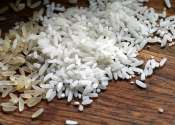Seed microorganisms override soil microorganisms when colonizing plants
New research shows that when it comes to colonizing plants, microorganisms from seeds have more staying power than microorganisms from the soil.

New research shows that when it comes to colonizing plants, microorganisms from seeds have more staying power than microorganisms from the soil.
Plants & Animals
Dec 16, 2021
0
8

How do you like your rice? Sticky, fluffy, brown, or white? These qualities, in addition to grain length, width, appearance, and other traits, are hugely important predictors of rice sales and consumption worldwide. And region ...
Plants & Animals
Nov 8, 2021
0
8

In a paper published in National Science Review, a Chinese group of palaeobotanists described a new genus and species of Late Devonian ovule (seed before fertilization), Guazia dongzhiensis gen. et sp. nov., which is borne ...
Plants & Animals
Nov 8, 2021
0
5

The endosperm, the tissue surrounding the plant embryo in the seed, has long been perceived as a nourishing tissue that is abandoned once the transition to the seedling is complete. A Swiss team, led by scientists from the ...
Cell & Microbiology
Oct 26, 2021
0
30

Crosstalk among Abscisic acid (ABA), auxin, and reactive oxygen species (ROS) plays critical roles in modulating seed germination, root growth, and suberization. However, the underlying molecular mechanisms remain largely ...
Molecular & Computational biology
Oct 25, 2021
0
6

Fruits can be dichotomously classified as fleshy or dry. Although many factors have been proposed to explain the pattern that the fleshy-fruited species occur with deceasing latitude and altitude, the relative importance ...
Plants & Animals
Oct 18, 2021
0
9

If you're going apple picking this fall, you may find yourself being drawn to the biggest, brightest, and most aromatic apples you can find. Apple trees and other fruit-bearing plants have evolved to produce such appetizing ...
Plants & Animals
Oct 6, 2021
0
107

Scientists have figured out how plants respond to light and can flip this genetic switch to encourage food growth. The discovery could help increase food supply for an expanding population with shrinking opportunities for ...
Plants & Animals
Oct 6, 2021
0
154

Scientists seeking to unravel the details of how plants produce and accumulate oil have identified a new essential component of the assembly line. They discovered a particular sterol—a molecule related to cholesterol—that ...
Biotechnology
Sep 22, 2021
15
52

Green shoots emerging from black tree trunks is an iconic image in the days following bushfires, thanks to the remarkable ability of many native plants to survive even the most intense flames.
Environment
Sep 21, 2021
0
20